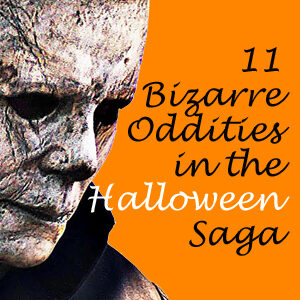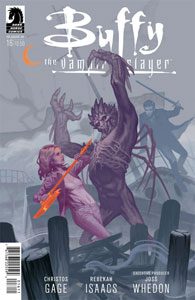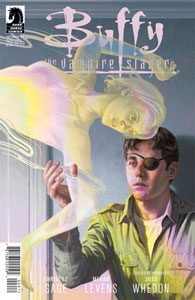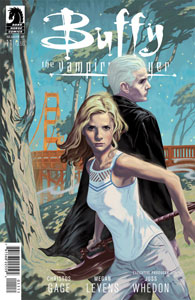I gave some leeway to the start of “Buffy” Season 10, allowing writer Christos Gage to get up to speed. But the middle batch continues to be uneven, showing that he’s not quite as good as Andrew Chambliss (“Buffy” Season 9) and that he himself has taken a step back from “Angel & Faith” Season 9.
These issues tend to be talky, but the worst part is that they’re short on the trademark “Buffy” undercutting of clichés. The narratives play out in straightforward fashion. On the other hand, everyone is in character — and Gage does dig deeply into the characters, like he’s analyzing them in story form. He’s not embarrassing the brand by any means – and Rebekah Isaacs remains an elite artist — but I’d like to see a little more zest out of this season.
“Love Dares You” (Issues 11-13, January-March 2015)
“Love Dares You” marks the moment on my first read when my suspicion that “Buffy” had descended into being merely good, rather than great, was realized. Andrew’s arc illustrates this. A sexually ambiguous character, he is revealed to be gay in Issue 10 after drinking a confidence-boosting potion and kissing a guy. Of course, there’s nothing in and of itself wrong with Andrew being gay, but this revelation does nicely illustrate the Buffyverse’s struggles with portraying diversity based on groups.
In terms of digging into individuals’ unique personalities, “Buffy” is a master class, but a lot of the saga’s diversity based on the broad labels of race and sexual orientation feels forced. Willow, an established straight character turned gay, is an example so obvious that the writers themselves make fun of it when the Buffybot labels her “Gay, 1999-Present” in “Intervention” (5.18). Around the same time, Gunn was added to “Angel” with the openly expressed goal of racial diversity in the main cast. A more recent example is setting aside two Season 9 issues to introduce Billy, whose defining trait is that he’s gay.
Unlike Billy’s, Andrew’s story is an organic part of the narrative, but it comes in an arc where both Buffy and Spike rightly complain about the notion that everyone has to be paired up all the time. From a fan-pressure standpoint, obviously you can’t tell a sexual-awakening story wherein the vaguely effeminate but mostly asexual Andrew turns out to be straight; it’s not worth the criticism. But this is a second missed opportunity (after Willow) to add a bisexual character. Even better, if Gage had expanded the notion of diversity beyond sexual orientation, Andrew could’ve been given a defined social-anxiety disorder.
I can’t be too hard on “Love Dares You,” though, because – as noted – the Buffyverse is good at detailed individual characterization. I particularly appreciate that Xander stands up for Spike when the vampire finds himself in a similar predicament to Season 7. Based on his dreams, Spike thinks he’s killing people, being controlled by an outside force. It’d be easy to have Xander do his expected thing of hating Spike’s guts, but Gage recognizes that Xander has seen Spike’s decency on display for nearly a decade now – plus, they have the bond of caring deeply about the Summers girls. Xander is no dummy – he has a stake and cross ready – but he stands up for his roommate Spike when Giles and Willow doubt him.

Gage also impeccably handles Giles, balancing the fact that he’s all Giles but his brain is bombarded by the hormones of adolescence. His longtime hookup Olivia can only be in his life as a friend, for reasons obvious to her and readers, but which make “12-year-old” Giles furious and frustrated.
The Buffy-and-Spike hookup has to be addressed, because that’s what everyone cares about regarding “Love Dares You.” On my first reading, it felt redundant to previous Spike-Buffy flings and almost-flings, but reading it in a flow without a one-month gap between issues, I see this is distinct. Buffy recognizes the ensouled Spike is different from the pre-soul Spike in the same way Angelus and Angel are different. There are two notable distinctions, though: 1, Spike doesn’t have a curse on him, and 2, society (within the pages of “Buffy,” a hopeful extrapolation from the positives about modern society) is now more open to unconventional relationships.
But Season 10 is getting awfully talky – sort of like Season 7, but comics are limited by imagination, not budget, so it’s less excusable here. And there’s no hint of a Big Bad (on this re-read, I view D’Hoffryn with more suspicion but that doesn’t change the fact that there’s little sense of menace or threat to the narrative). “Love Dares You” — illustrated by Megan Levens, who is solid but not as good at facial nuances as Isaacs — has the strange status of being a memorable mixed bag.
3 stars

“Relationship Status: Complicated” (Issues 14-15, April-May 2015)
This two-parter is a prime example of how Isaacs often tells the story, even if Gage writes it. Buffy enters Spike’s mind while both are dreaming, and anyone can predict what will happen – in fact, the characters know as much beforehand: Buffy witnesses many horrible things Spike did without a soul, but also sees how much he loves her. Isaacs sells it with Buffy’s expressions, and with the illustrations of Spike’s memories (tip of the hat to colorist Dan Jackson, too). And I like how Willow’s face is floating nearby, guiding Buffy.
The culprit behind Spike’s false visions of murder is Archaeus, the vampire who sired the Master, and who can therefore influence all vampires of his lineage. (This includes Angel, so Spike gives him a courtesy call of warning, although his greeting is predictably rude.) As far as Big Bads go, Archaeus is arguably too similar to Maloker, the First Vampire, whom the gang had recently defeated at the end of the Seedless world and again at the start of the newly Seeded world.
But Spike having to fight his inner demon – as spurred on by Archaeus — is a nice test for him, and even more so for Buffy. She refuses her friends’ pleas to dust the out-of-control Spike, betting her life that he won’t kill her. It’s an intense way to illustrate that Buffy loves Spike; she’s not merely saying it.
4 stars

“Old Demons” (Issues 16-18, June-August 2015)
This three-parter has a better blend of dialog and action than we’ve seen in a while. It’s arguably fan service to have Angel join the group in San Francisco to mount an attack against Archaeus, but it’s a good time for fan service, because a lot of the simmering relationship problems get ironed out. Even Xander and Angel tell each other they’re good by the end.
Before the gang goes after Archaeus, Dawn is going to hand out weapons, but first she asks: “Is everyone going to behave?” Isaacs gives us a few panels of Buffy, Spike, Angel, Xander, Giles and Willow exchanging glances. Gage may write in a Season 7-esque talky style I don’t care for, but there’s no question he knows all of these people inside and out.
The overall plot isn’t surprising; there’s a moment when Angel attacks Spike while under Archaeus’ influence, but then he predictably fights it off, as Spike did in the previous arc. The pleasures come more from Gage getting into a rhythm of action and character beats.
For instance, as they journey through the sewer in search of the Big Bad, Spike tries to explain to Buffy why he’s different from Angel, but frustrates himself by getting caught on the similarities; it’s an oldie but a goodie – although he might want to find new material. And there’s also a hallway fight against a monster in this year when “Daredevil” made hallway fights into a trope, as Angel, Spike and Buffy awkwardly learn to fight as a three-pronged team.
There’s also this fun bit from the sewer trek:
Giles (to Xander): “Don’t be ridiculous. Alligators in the sewers are sheer fantasy. Do be on the lookout for rat-spiders, though. They favor such environments.”
Later, we smash-cut to the group fighting a bunch of rat-spiders, with Giles webbed to the wall.
4 stars

“Freaky Giles Day” (Issue 19, September 2015)
Like many issues this season, “Freaky Giles Day” has the enjoyable “Buffy” rhythms but lacks any surprises. Willow devises a spell to make Giles an adult for a day, and what transpires is what you’d guess – with some humor, granted. Kid-Giles texts Olivia almost before Willow finishes suggesting the idea. He does adult things he missed, such as test-driving a car.
The final page is the best epilogue of the season – and a rare case where Gage allows a scene to be wordless — as Buffy simply hugs adult-Giles on the rooftop as the sun sets on the day and the spell. She’s an adult, but even adults need their parents sometimes, and Buffy hasn’t seen this Giles since Season 8, which was several years ago.
Earlier in the issue, Buffy’s biological dad, Hank, has lunch with his daughters, as he has moved back to California after living in Europe. The saga has always had a tricky time dealing with Hank. He’s often portrayed as an absent father more so than an evil person, which is nice, but this also makes his absence seem inexplicable. He was present for most of Buffy’s and Dawn’s childhoods, and it never felt quite right that his mostly amicable divorce from Joyce would mean he’d rarely see his kids again.
This issue – Hank’s only appearance in the canonical comics – does the work of making him into a worse person in order to justify his continuing absence. We learn he calls his daughters once a month, which is more than I would’ve guessed. But then he puts down his most epic bad-dad card, telling Buffy and Dawn he’s getting married but Buffy can’t come to the wedding because she draws violence where she goes. We now have a more concrete answer when wondering “Why is Hank not in Buffy’s and Dawn’s lives?” But he remains perhaps the flattest, least-satisfying recurring character in the Buffyverse – which I know is part of the point, but still.
4 stars

“Triggers” (Issue 20, October 2015)
“Triggers” is on-the-nose message-y about the topic of domestic violence, with an incubus serving as barely-a-metaphor for abusive men. We get an interesting wrinkle with how this situation plays out in the New Rules world, though. While Gage has shelved the “Vampyr” book for many issues now, “Triggers” illustrates a non-codified way the world has changed: Monsters can’t use the shadows as effectively now that people know monsters exist. “They liked it when people didn’t believe in them,” Buffy says after killing the incubus. “Were afraid to talk about them ’cause they’d be made fun of or called crazy. New rules now.”
The best part of “Triggers” is that we finally get a juicy mystery. A demon informs Xander that the supposed ghost of Anya he’s been talking to off and on is not truly Anya. And the ghost later learns for herself that she is not Anya, although her mysterious boss asks “Does it matter? When this is over, you’ll be as real as she was.”
3.5 stars
Click here for an index of all of John’s “Buffy” and “Angel” reviews.

